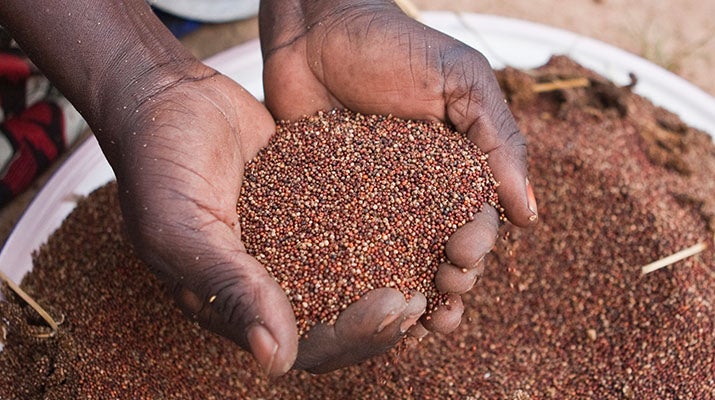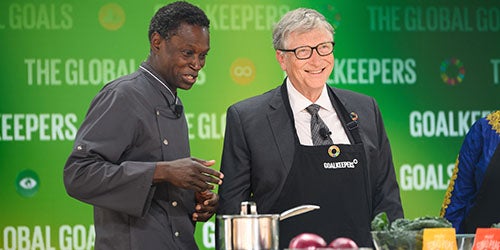Why We’re Polarized is fundamentally a book about American politics, but I thought it was also a fascinating look at human psychology.
What grain did your family grow up eating? I’m from the United States, where wheat and corn are king. But if I had been born in East Asia, I probably would’ve eaten a lot more rice as a kid.
If you grew up in West Africa, you might have eaten an ancient grain called fonio. Fonio has been feeding families in West Africa for more than 5,000 years, longer than any other cultivated grain on the continent. That makes it older than toilets, the wheel, and even writing. It’s a super small grain with a texture that reminds me a bit of couscous when cooked in hot water. Its nutty taste is delicious on its own but is also good when ground into flour.
Fonio is just one part of a much bigger family of remarkable ancient grains: the millets. Perhaps you’ve heard of finger millet. It’s a staple in Uganda and parts of Kenya and Tanzania, and it’s beloved in India where it is called ragi. Or maybe you’ve heard of teff, a longtime favorite in Ethiopia where it’s used to make injera.
Millets have been around for centuries, but they’re currently experiencing a resurgence—both for consumers who enjoy their taste and for farmers who appreciate how reliable they are to grow.
Fonio, in particular, is like farming on easy mode. You wait until a good rain comes, lightly till the soil to loosen it up, and then scatter the seeds on the ground. Two months later, you harvest the grain.

Farmers in Senegal harvest fonio stalks to be processed.
No wonder West African farmers call it the “lazy farmer’s crop”! Fonio grows in the Sahel, a semi-arid region just south of the Sahara Desert. To thrive there, a crop must be drought-tolerant and able to grow in poor quality soil. Fonio not only handles the dry conditions with ease but even rejuvenates the soil as it grows.
As climate change continues to make growing seasons more unpredictable, crops like the millets will become more and more important. The Gates Foundation has been working with partners like CGIAR for years to make staple crops like corn and rice more climate resilient. Millets naturally have many of the qualities farmers look for in a crop, and they could play an important role in helping farmers adapt to a warming world.
They can also help us fight malnutrition. When Europeans first arrived in West Africa, they called fonio “hungry rice” because it grew so quickly that you could eat it at times when other foods weren’t available. Today, many people would probably call it a “superfood.”
Consider this:
- Fonio is a great source of protein, fiber, iron, zinc and several key amino acids.
- Finger millet has 10 times the calcium of wheat.
- Teff is the only grain that is high in vitamin C.
In a world where food security is increasingly uncertain in some parts of the world, these foods could be a game changer. I’ve written a lot on this blog about how malnutrition is the first problem I would solve if I had a magic wand. Having access to a high-quality nutrition source could help more kids’ development stay on track.

Nutritious and drought-tolerant, finger millet could bolster food security in Africa.

It makes a delicious porridge, too.
Nutritious and drought-tolerant, finger millet could bolster food security in Africa.
It makes a delicious porridge, too.
So if millets have so much going for them, why aren’t they eaten everywhere?
In the case of fonio, the answer is simple: Until recently, it was hard to process on a commercial scale. The part you eat is surrounded by a hard hull, which was traditionally removed by skilled women using either a mortar and pestle or their feet to crack the shell. It’s a time- and labor- intensive process that makes it hard to turn a profit. In Senegal, only 10 percent of the fonio grown is sold at market—nearly all of it is consumed directly by farmers and their families.

Traditionally, harvesting fonio is hard work. Skilled women use their feet to remove the hard hull surrounding the part you eat.

It’s time intensive as well, taking up to seven hours to clean, wash, dry and pre-cook the grain.
Traditionally, harvesting fonio is hard work. Skilled women use their feet to remove the hard hull surrounding the part you eat.
It’s time intensive as well, taking up to seven hours to clean, wash, dry and pre-cook the grain.
Luckily, that’s changing. Terra Ingredients—an American company that is helping to bring the grain across the Atlantic—recently partnered with a Senegalese company called CAA to build a commercial processing facility right in Dakar. I got to visit it during my trip, and it was inspiring to see how they’re enabling local farmers to earn a better living.
Initiatives are also underway to improve the market presence of crops like teff, the millet used to make injera, which is gaining international popularity as a gluten-free option. It’s even on the rise within Ethiopia. Thanks to the increased availability of teff flour and ready-made injera, the country has seen a nearly 50 percent increase in teff mills, injera-making enterprises, and retail outlets. Food scientists are also developing new processes and products for finger millet. It’s now eaten in schools across Kenya as part of the ugali porridge served during lunch.
Yet, many people still just don’t know about the magic millets. Despite their potential, all of the millets I’ve mentioned are what experts call “neglected and underutilized crops,” a term that refers to crops that have fallen into disuse and been historically ignored by agricultural R&D.
That’s changing, too, in part due to the efforts of one person: Pierre Thiam. He’s a Senegalese chef who has made it his mission to create more opportunity for African farmers and spread the word about what he calls “lost crops.” (He’s even hosting a conference focused on them in Dakar later this year.) I was lucky enough to get a lesson in cooking fonio from him at the Gates Foundation’s Goalkeepers event in 2022—the mango salad we made was delicious.

I had a great time learning how to cook fonio with Chef Pierre at Goalkeepers in 2022.
Chef Pierre understands that one grain—or even a whole magic family of grains—isn’t the answer to the world’s food security problems. We need to build strong, diverse food systems that pull from lots of different sources. But if you want to understand how to help farmers adapt to climate change and make crops more resilient, ancient grains like the millets are a great place to start. They’ve survived for centuries, so they’re clearly doing something right!




